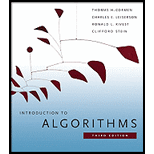
Concept explainers
(a)
To prove that exactly
(a)
Explanation of Solution
The input array has distinct elements and each element is equally likely so the distribution is uniformly supported on the array.
As the array has n elements then the probability of each element occurs as
Since, there are distinct n elements so thepermutation of the leaf nodes is exactly
(b)
To shows
(b)
Explanation of Solution
Suppose the tree T then the depth of particular elements of LT is one less than the depth of the tree so the
Since the minimum length of the left leaf and the minimum length of the right leaf are equals to the length of the tree there is another variable k which defines the constant increasing in the path defined in the minimum path of the length.
Therefore,
(c)
To show that
(c)
Explanation of Solution
Suppose a tree T having leaves node k, LT and RT be minimum length path of left and right leaves then the equation of the tree is defined as follows:
Suppose the minimum path length equation of the tree as follows:
Now, suppose the LT have
For the minimum external path length the value of the equation is consider as minimum value of the i value of the
(d)
To show that the function
(d)
Explanation of Solution
Suppose i is a continuous variable and it finds the critical points using derivatives of the tree equation
Suppose it picks the two sub-trees of approx. equal sizes then the depth of the tree is equals to
Suppose the tree equation
Taking the log on both sides with derivate of the equation.
Putting the value
As
Therefore, the equation
(e)
To show that
(e)
Explanation of Solution
Suppose that a tree with k leaves needs to have external length
The average-case is the situation in which the
Since the average-case run time is the depth of a leaf weighted by the probability of that leaf being the one that occurs.
Therefore, the running time is
(f)
To show that for any randomized comparison sort B , there is a deterministic comparison sort A whose expected number of comparisons is no more than those made by B .
(f)
Explanation of Solution
The expected running time is the average over all possible results from the random bits. The equation of the tree is defined as follows:
The comparisons sort of B has the randomness that has higher value than the deterministic comparisons of A. The random sorting algorithm uses the partition of the array and uses the random sorting values for the dividing the array.
The possible fixing of the randomness resulted in a higher runtime, the average would have to be higher than the other so comparisons sort of B has higher value.
Want to see more full solutions like this?
Chapter 8 Solutions
Introduction to Algorithms
- Please solve and answer the questions correctly please. Thank you!!arrow_forwardConsidering the TM example of binary sum ( see attached)do the step-by-step of execution for the binary numbers 1101 and 11. Feel free to use the Formal Language Editor Tool to execute it; Write it down the current state of the tape (including the head position) and indicate the current state of the TM at each step.arrow_forwardI need help on inculding additonal code where I can can do the opposite code of MatLab, where the function of t that I enter becomes the result of F(t), in other words, turning the time-domain f(t) into the frequency-domain function F(s):arrow_forward
 Operations Research : Applications and AlgorithmsComputer ScienceISBN:9780534380588Author:Wayne L. WinstonPublisher:Brooks Cole
Operations Research : Applications and AlgorithmsComputer ScienceISBN:9780534380588Author:Wayne L. WinstonPublisher:Brooks Cole C++ Programming: From Problem Analysis to Program...Computer ScienceISBN:9781337102087Author:D. S. MalikPublisher:Cengage Learning
C++ Programming: From Problem Analysis to Program...Computer ScienceISBN:9781337102087Author:D. S. MalikPublisher:Cengage Learning Fundamentals of Information SystemsComputer ScienceISBN:9781305082168Author:Ralph Stair, George ReynoldsPublisher:Cengage Learning
Fundamentals of Information SystemsComputer ScienceISBN:9781305082168Author:Ralph Stair, George ReynoldsPublisher:Cengage Learning


